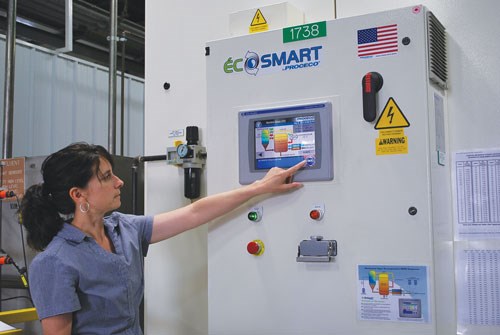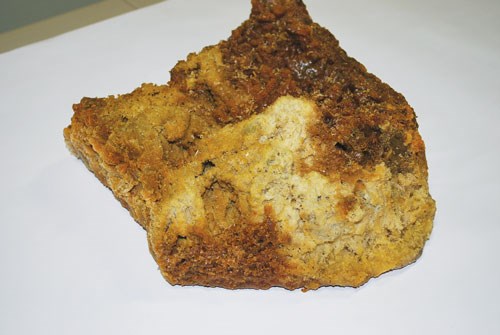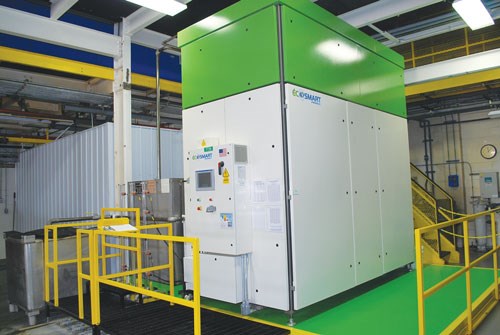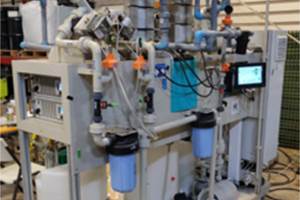Ground Zero for Industrial Parts Cleaning Discharge
Proceco helps the R.H. Sheppard Co. attain zero waste after parts cleaning.
Share
When the R. H. Sheppard Co. in Hanover, Penn., decided to double its wastewater processing capabilities, it had big expectations for the 600,000-sq-ft production facility that designs and manufactures engineered products for the truck, bus, rail, construction, military and recreational vehicle industries.
They certainly weren’t vague on what they wanted discharged into any municipal drain or collection device: “Nothing will leave this plant. Zero discharge, period.”
That meant filtering out emulsified oils and solids from parts cleaning, various manufacturing and surface finishing operations. This task fell on the shoulders of Allen Leppo, Sheppard’s director of maintenance and automation who oversees the wastewater facility at the plant.
Leppo says the plant was using an atmospheric standard evaporator to reduce the volume of clarified wastewater. The vapor was condensed using a chiller, a high-energy consuming process that was very costly and required significant maintenance.
Zero Discharge
The evaporator required natural gas, electric, and a 20-ton chiller that ran 24/7, he says.

Julie Smith, director or safety and environmental health for Sheppard, adjusts the Éco-Smart system, which is fully automatic and can be continuously monitored on the machine’s touchscreen interface.
“Our first priority was energy consumption. I preferred one energy source: electric,” Leppo says. “We also did not desire a condenser to cool the distillate, and we required the output for 24 hours to exceed 2,000 gallons.”
That’s because much is going on at the Sheppard plant, which specializes in manufacturing heavy-duty power steering gears and assemblies, remanufactured steering gears and special products such as high-pressure fuel pumps.
The company was founded in 1937, and is one of the larger producers of compacted graphite castings in the U.S. They also produce various grades of gray, ductile and austempered ductile iron.
However, in 1963 the company decided to focus on manufacturing power steering components, and has become one of the best in the business, earning more than two dozen patents on steering during that time.
Leppo, meanwhile, has an extensive background in building parts cleaning equipment himself, having received a U.S. patent on cleaning machines, including one for the parts cleaner that removes cutting oils from machined parts.
Closed-Loop Systems
For the new wastewater treatment equipment, he did quite a bit of research on closed-loop systems and came across one made by Proceco Ltd. in Montreal which is a mechanical vapor recompression evaporator.

Dissolved solids are all that remain after the effluent sent to the Éco-Smart is either ultrafiltration permeate or reverse osmosis retentate.
Proceco sent Sheppard a pilot unit that Leppo was able to try out on his plant floor. The Éco-Smart system distills clarified wastewater under vacuum without using an external heat source, meaning it didn’t need electrical heaters, gas burners or a stream source.
Robert Burns, president of Proceco, says the Éco-Smart system provides great energy and cost savings by using only the heat generated by the compressor and the heat contained in the distillate as energy sources.
“The Éco-Smart system produces clean distillate water they can use as process make-up water while the wastes are concentrated for disposal,” Burns says. “Manufacturers can save money and minimize their environmental impact at the same time.”
Based on the test results, Sheppard ordered a system from Proceco for the Hanover facility. Leppo and his crew at Sheppard had to get the space prepared for the machine, but that wasn’t difficult.
“The entire first floor of our wastewater facility is designed to collect and control any leaks or spills that may occur,” Leppo says. “We simply poured a cement pad to provide a level mounting surface per Proceco’s specifications. All labor and curing time required approximately two weeks.”
Less Consumption
The result since the installation late last year has been pleasing to Sheppard. While the Proceco machine does not enhance its “zero discharge” to the municipality, Leppo said it does greatly reduce the company’s utilities consumption.

The Éco-Smart system from Proceco.
“Final figures are not yet available, but we have increased our throughput 400 percent over our previous evaporator,” he says. “Now we require only electricity, and we have reduced the amount of run time by 50 percent. This increased capability has allowed us to reduce the run time of other phases of our recycling process.”
The Éco-Smart system uses a compressor to increase the pressure of the water vapor or steam it produces. An increase in the vapor pressure increases the condensation temperature of the steam, thereby making it usable to heat the original mixture in a heat exchanger.
“It is this resulting temperature difference produced by compressing the steam that enables a highly efficient heat transfer to occur,” Burns says. “As the steam condenses in the heating chamber, it releases its latent heat of vaporization to further heat the original mixture, which in turn produces more steam.”
Essentially, incoming wastewater is pre-heated by the heat available in the distillate being produced, and then the wastewater evaporates under a partial vacuum in the main heat exchanger. Burns says that the evaporate—or steam—is compressed and returned to the main heat exchanger where it is condensed, and the latent heat goes back into the system.
98% Reclaimed
The condensate is then released in the form of high-quality distillate, which Burns says in most cases is ready for reuse or to be sent to drain. Proceco claims that up to 98 percent of wastewater can be reclaimed as clean water.
Burns says the energy consumption is about 0.25kWh/gal, which is considered very economical.
Leppo says Sheppard processes one to three runs per week which includes the Éco-Smart system, with a normal run at about 10,800 gallons, depending on production requirements and the season of the year with air compressor condensate.
The effluent sent to the Éco-Smart is either ultrafiltration permeate, or reverse osmosis retentate. In both cases, Leppo says, the effluent is oil-free, adding that the main difference is the amount of total dissolved solids.
“With the addition of the Proceco machine, we have concentrated our waste stream by at least 50 percent,” Leppo says, adding that the minimum amount of wastewater sent to the Éco-Smart system is the reverse osmosis retentate, which is 25 percent by volume.
“The Proceco equipment allows us to run independent or in conjunction with the reverse osmosis units thus lessening the requirements placed on the ROs,” he says.
Running Smoothly
After tinkering with a troubled valve after initial installation, the Éco-Smart system has been running smoothly for Sheppard.
“I have never had a new piece of equipment start up without any challenges,” Leppo says. “The support from Proceco has been unsurpassed.”
Any manufacturer considering installing a similar wastewater treatment system should heed Leppo’s advice: Perform thorough research by testing as he did with Proceco’s pilot unit, test the distillate and retentate, calculate throughput capabilities, and then predict energy savings.
“Not only does the wastewater recycling allow us to achieve zero discharge, it also allows us to be able to significantly reduce the amount of city water required for our industrial process,” says Julie Smith, director or safety and environmental health for Sheppard.
For more information on Proceco Éco-Smart MVR evaporators, visit proceco.com/eco_smart
Related Content
Replacing Open-Top Vapor Degreasing in Aerospace Manufacturing
Options and considerations for cleaning aerospace parts as regulations tighten on vapor degreasing solvents.
Read MoreTTX Environmental Solves Customer Issue with Electro-Ceramic Desalination Wastewater Processing
Electroplating facility without access to a drainage system found a safe solution for wastewater treatment and reuse.
Read MoreHow Vapor Degreasing Helps Medical Devices Cross the Finish Line
Vapor degreaser cleaning can be simple, predictable and repeatable, making it a good fit for medical device manufacturing.
Read MoreAdvantages to Pumped Eductor Agitation
Not all agitation methods are created equally. Pumped agitation with eductor nozzles can improve process tanks and quickly show a reduction in operating costs while keeping staff safe, following environmental legislation and preventing pollution.
Read MoreRead Next
Masking Solutions for Medical Applications
According to Custom Fabricating and Supplies, a cleanroom is ideal for converting, die cutting, laminating, slitting, packaging and assembly of medical-grade products.
Read MoreA ‘Clean’ Agenda Offers Unique Presentations in Chicago
The 2024 Parts Cleaning Conference, co-located with the International Manufacturing Technology Show, includes presentations by several speakers who are new to the conference and topics that have not been covered in past editions of this event.
Read More



















